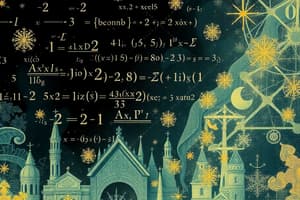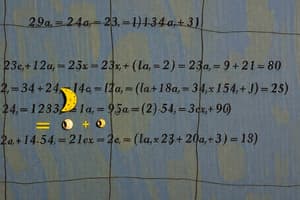Podcast
Questions and Answers
Which of the following is an algebraic expression?
Which of the following is an algebraic expression?
- $4a + 6b - 2$ (correct)
- $x = 9$
- $5x + 3 = 8$
- $7y - 2 > 10$
In the term $7y$, the coefficient is $y$.
In the term $7y$, the coefficient is $y$.
False (B)
What is the value of $x$ in the following equation: $2x + 5 = 11$?
What is the value of $x$ in the following equation: $2x + 5 = 11$?
3
The standard form of a linear equation is $ax + b = ______$, where $a$, $b$, and $c$ are constants.
The standard form of a linear equation is $ax + b = ______$, where $a$, $b$, and $c$ are constants.
Match the following terms with their definitions:
Match the following terms with their definitions:
According to the order of operations (PEMDAS/BODMAS), which operation should be performed first in the expression $2 + 3 * (4 - 1)^2$?
According to the order of operations (PEMDAS/BODMAS), which operation should be performed first in the expression $2 + 3 * (4 - 1)^2$?
The expression $5x^2 + 3x - 7$ is a binomial.
The expression $5x^2 + 3x - 7$ is a binomial.
What is the greatest common factor (GCF) of the polynomial $6x^3 + 9x^2 - 3x$?
What is the greatest common factor (GCF) of the polynomial $6x^3 + 9x^2 - 3x$?
The quadratic formula is $x = (-b ± √(b^2 - 4ac)) / (2a)$, and is used to solve for $x$ in a ______ equation.
The quadratic formula is $x = (-b ± √(b^2 - 4ac)) / (2a)$, and is used to solve for $x$ in a ______ equation.
Match each exponent rule with its corresponding expression:
Match each exponent rule with its corresponding expression:
Which method is NOT used for solving systems of equations?
Which method is NOT used for solving systems of equations?
When solving an inequality, multiplying both sides by a negative number does not change the direction of the inequality sign.
When solving an inequality, multiplying both sides by a negative number does not change the direction of the inequality sign.
Simplify the expression: $3(2x + 5) - (4x - 2)$
Simplify the expression: $3(2x + 5) - (4x - 2)$
In function notation, $f(x)$ represents the ______ of the function for a given input $x$.
In function notation, $f(x)$ represents the ______ of the function for a given input $x$.
Match the following terms with their corresponding examples:
Match the following terms with their corresponding examples:
Which of the following is the factored form of $x^2 - 4$?
Which of the following is the factored form of $x^2 - 4$?
The domain of a function is the set of all possible output values.
The domain of a function is the set of all possible output values.
Simplify the radical expression: $\sqrt{32}$
Simplify the radical expression: $\sqrt{32}$
To simplify rational expressions, you need to factor and cancel ______ factors.
To simplify rational expressions, you need to factor and cancel ______ factors.
Match each term to the correct property:
Match each term to the correct property:
Flashcards
What is Algebra?
What is Algebra?
A branch of mathematics that uses symbols and rules to manipulate them, representing quantities without fixed values using variables.
What is a Variable?
What is a Variable?
A symbol, usually a letter, representing a value that can change or is unknown.
What is a Constant?
What is a Constant?
A fixed value that does not change.
What is an Algebraic Expression?
What is an Algebraic Expression?
Signup and view all the flashcards
What is an Equation?
What is an Equation?
Signup and view all the flashcards
What is a Term?
What is a Term?
Signup and view all the flashcards
What are Like Terms?
What are Like Terms?
Signup and view all the flashcards
What is a Coefficient?
What is a Coefficient?
Signup and view all the flashcards
What is the Order of Operations?
What is the Order of Operations?
Signup and view all the flashcards
What is Simplifying Expressions?
What is Simplifying Expressions?
Signup and view all the flashcards
What is Solving Equations?
What is Solving Equations?
Signup and view all the flashcards
What is a Linear Equation?
What is a Linear Equation?
Signup and view all the flashcards
What is a Quadratic Equation?
What is a Quadratic Equation?
Signup and view all the flashcards
What are Systems of Equations?
What are Systems of Equations?
Signup and view all the flashcards
What are Inequalities?
What are Inequalities?
Signup and view all the flashcards
What is a Function?
What is a Function?
Signup and view all the flashcards
What is the Domain?
What is the Domain?
Signup and view all the flashcards
What is an Exponent?
What is an Exponent?
Signup and view all the flashcards
What is a Radical?
What is a Radical?
Signup and view all the flashcards
What is a Rational Expression?
What is a Rational Expression?
Signup and view all the flashcards
Study Notes
- Algebra is a branch of mathematics dealing with symbols and the rules for manipulating those symbols.
- These symbols represent quantities without fixed values, known as variables.
Variables and Constants
- A variable is a symbol (usually a letter) that represents a value that can change or is unknown.
- A constant is a fixed value that does not change.
Expressions
- An algebraic expression is a combination of variables, constants, and algebraic operations (addition, subtraction, multiplication, division, exponentiation, etc.).
- Example: 3x + 2y - 5 is an algebraic expression.
Equations
- An equation is a statement that two expressions are equal.
- It contains an equals sign (=).
- Example: 3x + 2 = 5 is an equation.
Terms
- A term is a single number or variable, or numbers and variables multiplied together.
- Terms are separated by + or - signs in an expression.
- Like terms have the same variables raised to the same powers and can be combined.
- Example: In the expression 4x + 3y - 2x + 5, 4x and -2x are like terms.
Coefficients
- A coefficient is the numerical factor of a term that contains a variable.
- Example: In the term 4x, 4 is the coefficient.
Basic Operations
- Addition: Combining like terms.
- Subtraction: Removing or reducing quantities.
- Multiplication: Repeated addition or scaling.
- Division: Splitting into equal parts.
Order of Operations
- The order of operations (PEMDAS/BODMAS) dictates the sequence in which operations should be performed.
- Parentheses/Brackets
- Exponents/Orders
- Multiplication and Division (from left to right)
- Addition and Subtraction (from left to right)
Simplifying Expressions
- Combining like terms to reduce the complexity of an expression.
- Using the distributive property to remove parentheses.
- Factoring: Expressing an expression as a product of its factors. Expanding: Multiplying out terms to remove parentheses.
Solving Equations
- The goal is to isolate the variable on one side of the equation to find its value.
- Use inverse operations to undo operations performed on the variable.
- Maintain balance by performing the same operation on both sides of the equation.
Linear Equations
- A linear equation is an equation in which the highest power of the variable is 1.
- Standard form: ax + b = c, where a, b, and c are constants and x is the variable.
- Solving linear equations involves isolating the variable.
Quadratic Equations
- A quadratic equation is an equation in which the highest power of the variable is 2.
- Standard form: ax² + bx + c = 0, where a, b, and c are constants and a ≠ 0.
- Methods for solving quadratic equations:
- Factoring
- Completing the square
- Quadratic formula: x = (-b ± √(b² - 4ac)) / (2a)
Systems of Equations
- A system of equations is a set of two or more equations with the same variables.
- Goal: find the values of the variables that satisfy all equations simultaneously.
- Methods for solving systems of equations:
- Substitution
- Elimination (Addition/Subtraction)
- Graphing
Inequalities
- An inequality is a statement that compares two expressions using inequality symbols: < (less than), > (greater than), ≤ (less than or equal to), ≥ (greater than or equal to), ≠ (not equal to).
- Solving inequalities is similar to solving equations, but multiplying or dividing by a negative number reverses the inequality sign.
Functions
- A function is a relation between a set of inputs and a set of permissible outputs with the property that each input is related to exactly one output.
- Notation: f(x), where x is the input and f(x) is the output.
Domain and Range
- The domain of a function is the set of all possible input values (x).
- The range of a function is the set of all possible output values (f(x)).
Graphing Functions
- Functions can be represented graphically on a coordinate plane.
- The graph of a function shows the relationship between input values (x-axis) and output values (y-axis).
Exponents
- An exponent indicates how many times a base number is multiplied by itself.
- Rules of exponents:
- xᵃ * xᵇ = xᵃ⁺ᵇ (Product of powers)
- xᵃ / xᵇ = xᵃ⁻ᵇ (Quotient of powers)
- (xᵃ)ᵇ = xᵃᵇ (Power of a power)
- (xy)ᵃ = xᵃyᵃ (Power of a product)
- (x/y)ᵃ = xᵃ/yᵃ (Power of a quotient)
- x⁰ = 1 (Zero exponent)
- x⁻ᵃ = 1/xᵃ (Negative exponent)
Radicals
- A radical is the root of a number (e.g., square root, cube root).
- The square root of x is written as √x.
- Simplifying radicals involves finding perfect square factors.
Polynomials
- A polynomial is an expression consisting of variables and coefficients, involving only the operations of addition, subtraction, multiplication, and non-negative integer exponents.
- Examples: x² + 3x + 2, 5x⁴ - 2x² + x - 7.
- Polynomials can be classified by the number of terms:
- Monomial: One term (e.g., 5x²)
- Binomial: Two terms (e.g., x + 3)
- Trinomial: Three terms (e.g., x² + 2x + 1)
Factoring Polynomials
- Factoring involves expressing a polynomial as a product of simpler polynomials.
- Common factoring techniques:
- Greatest Common Factor (GCF)
- Difference of Squares: a² - b² = (a + b)(a - b)
- Perfect Square Trinomials: a² + 2ab + b² = (a + b)², a² - 2ab + b² = (a - b)²
- Factoring by Grouping
- Factoring Quadratics
Rational Expressions
- A rational expression is a fraction where the numerator and denominator are polynomials.
- Simplifying rational expressions involves factoring and canceling common factors.
- Operations with rational expressions:
- Multiplication: Multiply numerators and denominators.
- Division: Multiply by the reciprocal of the divisor.
- Addition/Subtraction: Find a common denominator.
Studying That Suits You
Use AI to generate personalized quizzes and flashcards to suit your learning preferences.




